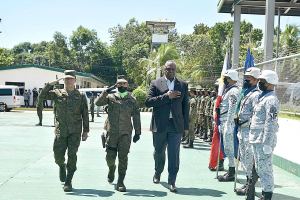
Mindanao landing US Defense Secretary Lloyd Austin 3rd visits the Western Mindanao Command at Camp Don Basilio Navarro in Zamboanga City on Wednesday, Feb. 1, 2023. Photo courtesy of WestMinCom
US Defense Secretary Lloyd Austin was in the Philippines Wednesday for talks about deploying US forces and weapons in more Philippine military camps to ramp up deterrence against China’s increasingly aggressive actions toward Taiwan and in the disputed South China Sea.
Austin flew Tuesday night to Manila from South Korea, where he met his counterpart.
Western Mindanao Command (Westmincom) commander Lt. Gen. Roy Galido, Armed Forces of the Philippines (AFP) Chief of Staff Gen. Andres Centino, and Philippine Navy Flag Officer in Command Vice Admiral Toribio Adaci Jr. welcomed Austin in Mindanao.
The officials discussed the continued support of Washington to Manila’s counterterrorism and humanitarian assistance and disaster response (HADR) operations, the mechanisms of which are all part of the Enhanced Defense Cooperation Agreement (EDCA).
The EDCA is a supplemental agreement to the previous Visiting Forces Agreement that allows the US to rotate troops into the Philippines for extended stays.
“[What was discussed was] the working relationship [of the two countries] which to them is very strong,” Galido said.
After the conference, Austin proceeded to meet with the more than 100 officers and members of the US Special Operations Task Force based in the Westmincom camp.
“[Austin] is just making sure that their troops here in Mindanao are OK,” Galido said.
The Philippines, Washington’s oldest treaty ally in Asia, has been a key front in the US battle against terrorism, especially after the Sept. 11, 2001, attacks. Austin met a small contingent of US counterterrorism forces on Wednesday in the south, where they have provided intelligence and combat advice for years.
More recently, US forces have intensified and broadened disaster response with Filipino troops in the Southeast Asian nation’s western coast, which faces the South China Sea, and in its northern Luzon region across the sea from the Taiwan Strait.
American forces have been granted access to five Philippine military camps, where they could stay indefinitely in rotating batches under the 2014 defense pact EDCA.
In October, the US sought access to a larger number of its forces and weapons to an additional five Philippine military camps, mostly in the main northern Luzon region, under the 2014 EDCA.
That request would be high on the agenda for Austin’s meetings in the Philippines, according to Philippine officials.
“The visit of Secretary Austin definitely, obviously will have to do with many of the ongoing discussions on the EDCA sites,” Philippine Ambassador to Washington Jose Romualdez said at a news briefing Tuesday in Manila.
The US defense chief is the latest American leader to visit the Philippines after Vice President Kamala Harris, who in a sign of warming ties after a strained period under Marcos’ predecessor, Rodrigo Duterte.
Romualdez said the Philippines needed to cooperate with Washington militarily to deter any escalation of tensions between China and Taiwan, not only because of the treaty alliance but to help prevent a major conflict.
“We’re in a Catch-22 situation. If China makes a move on Taiwan militarily, we’ll be affected — and all Asean region, but mostly us, Japan and South Korea,” Romualdez told The Associated Press, referring to the Association of Southeast Asian Nations, the 10-nation regional bloc that includes the Philippines.
The Philippines and Asean state members Brunei, Malaysia and Vietnam, along with Taiwan, have long been locked in increasingly tense territorial disputes with China in the South China Sea.
The US has been regarded as a crucial counterweight to China in the region and has pledged to come to the defense of the Philippines if Filipino forces, ships or aircraft come under attack in the contested waters.
The Philippines used to host two of the largest US Navy and Air Force bases outside the American mainland. The bases were shut down in the early 1990s.
Austin is scheduled to meet President Ferdinand Marcos Jr. and Defense Secretary Carlito Galvez Jr. He will also meet with Foreign Affairs Secretary Enrique Manalo.
Washington and Manila are hoping to build on the Balikatan exercise held last year, which is considered the largest iteration ever of the annual joint military exercise in its long history with around 9,000 troops participating.
The US has been very clear that its treaty commitments also apply in the West Philippine Sea and that an armed attack on Philippine forces, vessels or aircraft would be relevant to the defense treaty commitments that Washington and Manila signed.
